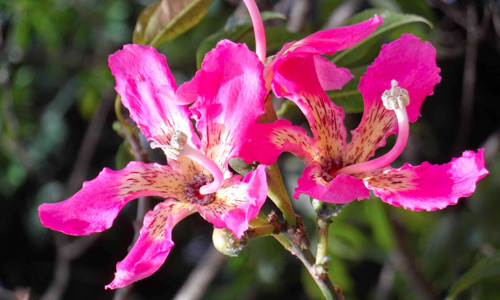|
Division
|
Angiosperms |
|
Class
|
Dicotledons |
|
Subclass |
Polypetalae |
|
Series |
Malvales |
|
Order |
Ficoidales |
|
Family
|
Bombacaceae |
|
Genus
|
Chorisia |
|
Species
|
speciosa |

|
Etymology:
|
In honour of Ludwig Choris (1795-1828), a well-known plant artist. |
|
Botanical name:
|
Chorisia speciosa St.-Hil. |
|
Local/Trade Names: |
Floss silk tree, Mexican silk cotton tree |
|
Conservation status:
|
Commonly found wild. |
|
Digonestic features:
|
Margin of the leaves crenately serrate from above the middle. |
|
Description: |
Large deciduous tree, upto 25 m high. Bark dark grey. Leaves deciduous, ovate, 5-8 x 2.5-4 cm, acuminate, base oblique, rounded or cuneate, margins crenately serrate from above the middle. Male racemes 1.5-2 cm long, bisexual, flowers pedicel 2 cm. Fruit a drupe, ovoid, ellipsoid, 5-6 mm long, orange red when ripe, bearing a tuft of pubescence at base and apex. |
|
Phenology: |
Fls.: May-June. Frts.: July-August. |
|
Distribution:
|
Outer Himalayas from Kumaon eastwards Meghalaya, Central India and eastern and Western Ghats. Myanmar. |
|
Where to see it: |
Arboretum near Japanese Garden Gate No. 2. |
|
Uses: |
Wood used for planking and canoes. Also used for match-boxes and splints. A very good fodder. |
Chief Conservator of Forests & Chief Wildlife Warden is the Head of the Department. There is one post of Conservator of Forests & two posts of Deputy Conservator of Forests viz.